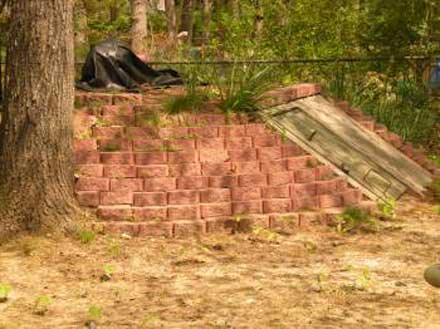
*How We Prepare For Severe Weather*
In this age of technology, most of us are fortunate to have access to information regarding upcoming severe weather. There is usually access to some type of early warning system, whether it be a weather radio, local televised reports, national weather stations, a tornado siren, AM/FM reports, internet, phone apps, a call from a neighbor or family member, etc. Regardless of your means of information, common sense and being aware of what is going on around you is extremely important.I am blessed to have an underground storm shelter. This gives an immense sense of peace. Due to the fact that I have been through many tornados, this is a must for me. Unless I have no choice, I will not own a house that doesnít have either a shelter or a "safe" area/basement. Even with a shelter, I realize there are still certain instances that could render minute problems. I still feel blessed to have one.

Example of one type of outdoor storm shelter.
We also know that we do not live in a "flood plain" area, so there are no worries about the shelter being flooded. There is a tornado siren in our community, but it has gone on the "blink" many times before. Often it will simply drain itself after it goes off repeatedly. You must depend upon your own instincts and prepare for any failure in communication. Do not be disheartened if you donít have a shelter, basement or safe room. In the absence of a designated safe area, it is extremely important to heed advice given as to the safest areas within your home. I have personally been in a bathtub with a mattress and/or pillows, inner hallways with a mattress, in a closet with pillows, under stair wells, under a table with pillows, and in partial basements, just to name a few. I would suggest you research the safest area(s) of your own home IN ADVANCE so that you will be prepared should the inevitable occur. BEING PREPARED is the key to any potential disaster. Whenever "shelter" is mentioned in this article, visualize that which you will be using as a shelter. Of course, there are times when tornados are so destructive that virtually any "safe" place may be impossible. However, we must strive and prepare regardless.
Again, I must reiterate that the most important aspect is to be aware. There are obvious differences between a nice sunny day and a hot, humid, stormy atmosphere. Check your local forecasts, and be conscientious of what may be approaching in days to come. The following information contains the personal process we go through when tornadic activity and/or severe thunderstorms with tornado watches are approaching. The specific storm I will be using as an example occurred during the horrid record-breaking tornados that occurred in the month of April 2011. Massive storms that hit early that Friday morning at about 1:30am left us (and the neighborhood) without power until Sunday afternoon around 4:30. Huge ancient trees were uprooted like twigs and tore power lines apart all over the place. Since we live in a suburb, naturally the city was the main focus for power restoration. Our grid was down for approximately 64 hours. Though our scenario may be different from your own, the basics should still apply. Through local and national weather information, we learned in advance that extremely severe weather was imminent. Thus began our preparations checklist. While we regularly maintain our generator, it was re-checked to make sure it was in perfect running order. Gasoline supplies were doubly checked, even though we knew they were adequate. Our generator isnít hard-wired in, so heavy-duty power cords are placed for easy access. A mechanicís floor lamp suffices for immediate lighting should the grid go down.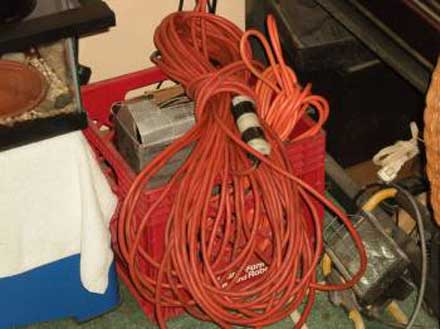
A mechanicís floor lamp
In preparation of losing power, necessary items are placed in an easily accessible area. Flashlights and the 2 portable AM/FM radio batteries were checked. I gathered appropriate batteries for each item should the need arise. Any rechargeable batteries were checked, charged if necessary, and put in an easily accessible area. I made sure both cell phones were fully charged as well. I then check our weather radio to ensure the battery backup is adequate should power be lost.
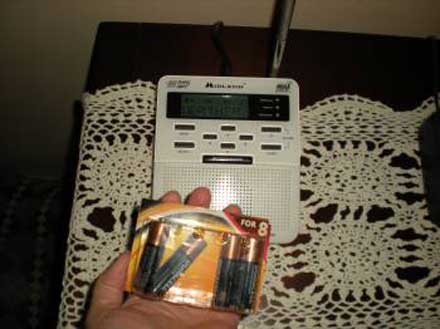
Checking our weather radio.
The weather radio sits on a nightstand beside the bed. Extra batteries are always available for the weather radio should we lose power and need weather updates. We use regular and rechargeable batteries and have them on hand at all times.
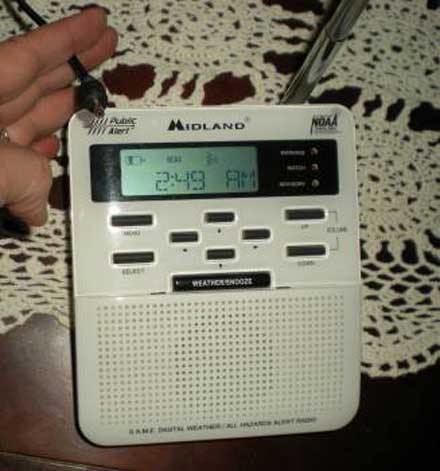
The weather radio is unplugged from the AC/DC adapter to make sure it is in working order. Note the battery icon. It is checked to make sure there is adequate battery back up as well. Batteries are replaced if necessary.
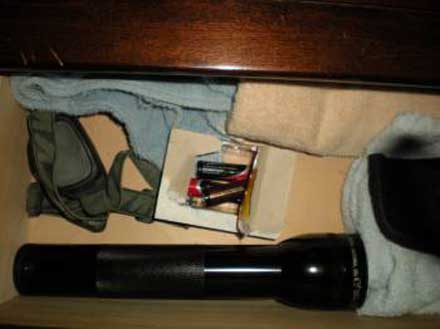
A flashlight and headlamp are stored in an easily accessible location. These are checked to make sure they are working properly and have full battery power.
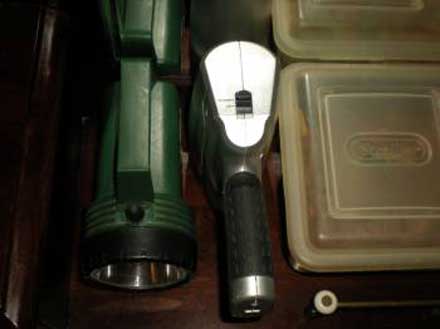
All other flashlights are checked to make sure bulbs are in proper working order. Batteries are checked and replaced if necessary, or fully charged in the case of AC/DC. These are always kept in easily accessible places anyway, regardless of storms, etc. I make sure the solar rope lights are fully charged and in the "off" position so the stored solar power will be "saved" until needed. (NOTE: These coiled solar rope lights make excellent night/bathroom lights when the power is off!)
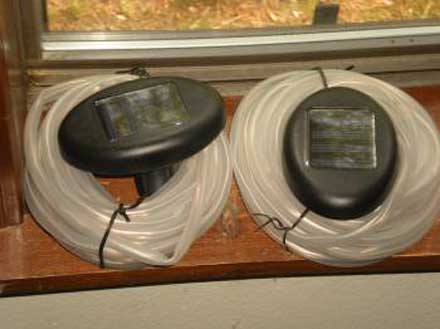
Solar rope lights
These inexpensive little solar rope lights sit in the windowsill daily so they will always be "ready" and on hand. I contact close family members to tell them we have severe weather approaching and that we are prepared and will stay in touch. They are given contact numbers of friends in our area. A close relative, who lives states away, is on "standby" in case we need accurate weather map updates for our specific area. We communicate via cell phone as long as service is possible. (Thankfully thus far we have maintained cell service through all storms.) Normally locked, the storm shelter is unlocked and surveyed, making sure everything is organized and there are "no surprises". Alternate lighting in the shelter is checked to make sure everything is in place and in proper working order. Additionally a small AM/FM radio is checked for adequate battery power. Within the shelter there is extra canned food, water, utensils, supplies etc. should a tree/debris block our shelter door and trap us inside for a time. There is also a bucket with a lid should the unimaginable occur and we need a toilet of sorts. This bucket also suffices for seating and storage. I canít state enough: BE PREPARED, even for the little unforeseen things! (NOTE: All these things are checked and maintained on an ongoing, regular basis! Still, it is important to check for any potential problems before the need arises. Things can go south in an instant without the proper preparation.)
Knowing that all was in order, we continued to monitor the path of the approaching storms via our local cable news. Routinely nothing changed for us, except the knowledge that storms were imminent. We carried on with "life as usual", knowing that we were ready. When it was clear that the direction of the storm/possible tornado was almost upon us we made sure our pets were inside and accounted for (dog, cat). The cat was placed in the pet carrier and positioned at the back door.
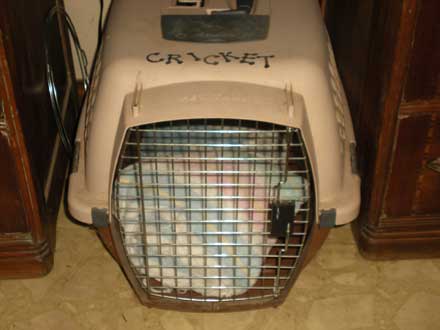
The cat carrier is 4 feet from the back door.
I then began to "pack my bag": This is a simple carry on type bag with a zipper so nothing falls out. This bag contains last minute items including our cell phones, wallets, checkbook, any extra cash on hand, social security cards, safe deposit box key, car/house keys, extra batteries, flashlight, extra small hands free headlamp, dog leash, personal protection, camera/video, etc. This bag would be a necessity should our home be destroyed or damaged by high winds or a tornado as we would need immediate access to these personal items. At the last minute I also grab the weather radio and place it in this bag as we are heading to shelter.
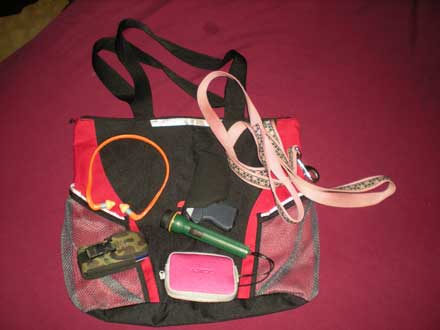
Here are just a few items that go in "the bag".
Although there are supplies and both food and water in both the shelter and the house, for convenience I also throw in a few dry snacks and a liter of water into the bag. (Other certain valuables were placed into the shelter in advance.) Hiking boots are placed by the back door as well: you donít want to be running around in house shoes or flimsy Chuckís if itís pouring rain and/or muddy. We also make sure we have on jeans versus sleep pants, etc. I keep an emergency pet kit packed at all times, regardless. This small kit contains enough food for each pet for a couple of days, as well as their vet/immunization records and a couple of "doggie downers". (You never know: if our home were destroyed in a tornado, etc., we may be forced to seek shelter in a place that requires such documentation. Possibly the pets may have to be boarded at a kennel for a few days, where immunization records are usually required). Also within easy access is my emergency backpack. (I carry it everywhere, local and otherwise.) This backpack is an extra precaution in lieu of the possibility of being trapped by debris while in the shelter, or in a worse case scenario: losing the contents of our home.
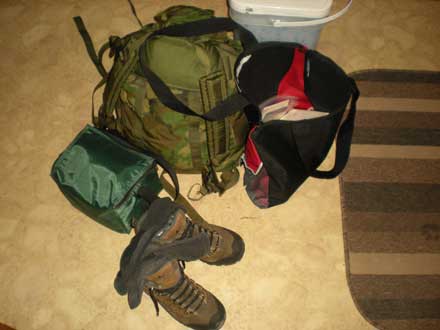
Sitting by the back door are hiking boots, "the bag" of important personal items, the 3-day backpack, and the pet "gear" and records. It takes less than 30 seconds to step into the shoes, sling the backpack on, and put a bag on each shoulder. This step is done ONLY when the tornado watch becomes a warning and the radio and sirens are going off.
We lost power early on, not long before the worst part of the storm hit. Our weather radio went straight to battery backup. (Keep in mind that if the weather radio failed, we still had access to the battery powered AM/FM, emergency standby contacts via cell, weather reports via cell, and a tornado siren). The generator was definitely not a safe option at this point. Within approximately 15 minutes, the NOAA weather radio indicated that rotation was upon us. Incidentally, the weather radio always goes off about one minute before our local tornado siren bellows. (Something to keep in mind when seconds count!)
As we are heading out the door to the shelter, the weather radio is put into "the bag" at the last second. The cat has already been put into the cat carrier. The dog is a "tornado trooper" and has been "storm shelter trained" and thinks itís great FUN. When the siren or weather radio goes off, she stands ready at the back door. (Of course we made sure sheíd had a "bathroom jaunt" in advance.)
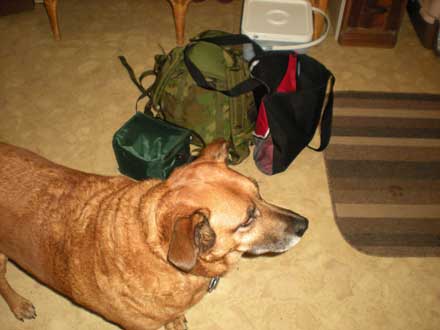
The "Tornado Trooper" stands ready to head to the shelter for what she deems a "tornado party". The cat... not so impressed with the situation.
Once inside the shelter, the weather radio comes out of the bag and we listen for updates. My "standby" family member is either text messaged or called and advised that we are in the shelter. He monitors the path of the storm via our county position/AO, giving us pinpoint positions of the tornado. Then we wait, using this time to talk, discuss the day, etc. The cat remains in the carrier during this time because he freaks. We were bombarded with wave upon wave of severe weather that night and early morning. We were in and out of the shelter multiple times. (Keep in mind we were without power.) On each occasion we went through the same last minute process. With the exception of the "personal effects bag", our backpacks, etc. remained in the shelter. After a fitful night of on and off sleep, we awoke to a neighborhood of moderately damaged homes, many large downed trees and broken power lines. Thankfully there was no loss of life in our immediate area. The brunt of the tornado skimmed over us in rotation and high winds. We lost power for a total of approximately 64 hours.
Additionally, Iíd like to relay a side note concerning an unexpected situation. In the midst of the first storm, the shelter door began to "leak". With the intensity of the storm increasing, water began pouring in rapidly. NOT good! We have a stock of feminine pads in medical supplies for wound use and some of these were used to absorb the cascade of water coming in during the torrential downpour. That was awesome, as some of our supplies (including us!) would have been standing in water by the time the storm was over! (We later found this was due to leaf trash that had gathered around a corner and wasnít sealing properly. This was promptly cleaned after that first storm and is now maintained!)
All in all, the main point is: BE PREPARED (and remember even the little things!). When the storms were over and the grid was down we started the generator. We ran it in 4-6 hour increments. This allowed us to keep our refrigerated perishables safe, and gave us light at night. We even watched a bit of television to catch up. Cell phones were used and charged as needed. We also have a landline that of course works during power outages.

The old standby: a cheap landline!
During the 64-hour grid down "challenge" we had no problems whatsoever. Fortunately we have a gas range, so we were able to heat water and cook. We had enough supplies to last for an extended period of time. Two huge stockpots were used to heat water for washing dishes and bathing. Incidentally, had the water and gas been unavailable, we were prepared for that as well.
In closing, here is a recap of our experience:
All in all, we fared extremely well! Prayers for those that didn't and for those families and communities that lost loved ones.
Tiaki-002
www.alpharubicon.com
All materials at this site not otherwise credited are Copyright © 1996 - 2011 Trip Williams. All rights reserved. May be reproduced for personal use only. Use of any material contained herein is subject to stated terms or written permission.